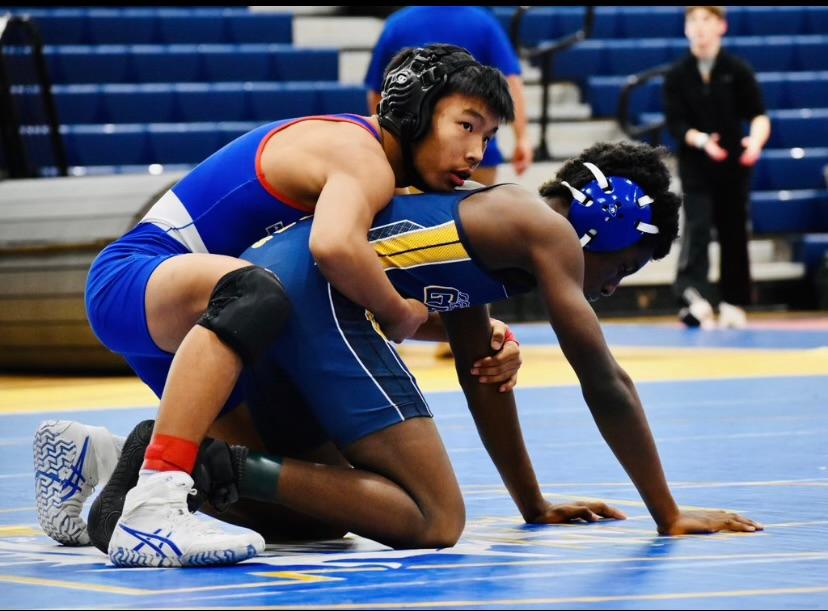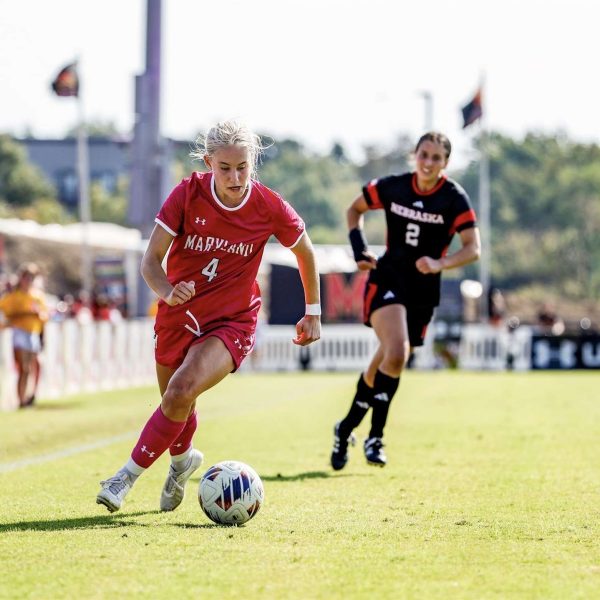How a winter sport teaches lessons that go way beyond the mat
Sophomore Argil Bilegsaikhan shows off a wrestling move he learned in practice during his match.
Hours of sparring in the wrestling room. Brutal weight cuts for match days. Long multi-mile runs developing endurance. All of these grueling physical and mental practices are what wrestlers have to go through everyday in preparation for a match. Balancing the individualism of the sport with the heavy challenges in preparation creates life changing lessons and develops better athleticism that can easily be transferred to other sports.
After school, a varsity practice consists of a cardio session starting at 3:30 where the team runs around two miles as warm up with different bodyweight exercises in between laps. This is followed by a 45-minute drilling session where wrestlers practice moves that they already know and try to perfect them for match day. For another 45 minutes after drilling, the wrestlers try out new moves that they can implement in matches and gain a tactical advantage. Similar to scrimmages in other sports, the wrestlers compete in live sparring sessions where they go head to head against each other at full speed to simulate a match day scenario. Finally, to conclude the two-hour long practice the team does an extensive stretch to prevent injuries and improve stability and balance.
These two-and-a-half hour-long practices are the longest for any winter sport, which helps to develop a strong work ethic for the wrestlers. Outside of wrestling, they can more easily tackle other challenges in life as well as in other sports. 75% of the wrestlers who competed in the last match day are multisport athletes. To put this into perspective, on the boys’ basketball team only about 21% of the players are multisport athletes. “Wrestling has helped me with my speed and strength and it has also helped me mentally. Wrestling is harder than 99% of all other activities so those seem a lot easier,” junior and three sport athlete Jake Kelley said.
Wrestling also works as a type of self defense and can act as a life-saving skill in cases of emergency. After high school, wrestlers can compete in college wrestling and eventually in the UFC (the leading mixed martial arts promotion) where a wrestling background has proven to be extremely successful in the sport.
Another challenging aspect of the sport is weight cutting. Wrestlers lose upwards of 10 pounds for every match to try to be as light as possible for the competition. They accomplish this by spending extensive periods of time in the sauna, drinking large amounts of water, wearing lots of layers to increase sweat and eating smaller portion sizes. This can get extremely dangerous though as wrestlers can develop eating disorders and lose lots of muscles during cuts.“As a wrestler the weight scale is my biggest enemy. The hardest part is not eating what I want to when my friends are eating meals like burgers and fries and I just have to settle for a small meal or a salad. I also think that it makes me mentally stronger because if I can withstand starving myself I can withstand anything my opponent has to offer, ” sophomore Argil Bilegsaikhan said.
Some healthy ways to supplement your weight cut would be eating all three meals in the day, eating high fiber and nutrient dense foods and increasing your cardio routine.
Your donation will support the student journalists of Thomas S. Wootton High School. Your contribution will allow us to purchase equipment and cover our annual website hosting costs.
Mason is a 2023 graduate.







